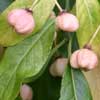 |
EUONYMUS europeus
f. albus The real thing! Vegetatively propagated to ensure the characteristic creamy-white seed pods are produced. (Watch out for cheap seedlings which can have a variety of fruit colours!) The orange seeds hanging within create a strong contrast. We have found this plant to be very prone to mildew, so have stopped propagating it. Even bigger, better white fruits are produced by the following cultivars of E. hamiltonianus - 'Koi Boy' and 'Popcorn'. |
|
|
|
| EUONYMUS europeus
'Brilliant' Quite distinctive, this narrow upright selection has bright pink fruits in the autumn. |
|
|
|
|
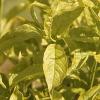 |
EUONYMUS europeus
'Chrysophyllus' A slow growing variant of our native spindle with delightful golden leaves. Good light is needed for best colour, adequate summer moisture will prevent scorch. |
|
|
|
| EUONYMUS
europeus 'Intermedius' The leaves of this cultivar are broader and more rounded at the base than is typical of the species. However, that distinction is of little relevance compared to the beauty of the profusion of coral-red fruit. |
|
|
|
|
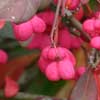 |
EUONYMUS
europeus 'Red Cascade' A striking form with orange fruits within red capsules. Excellent deep purple autumn colour as you would expect. Always reliable, whatever the weather. |
|
|
|
| EUONYMUS
europeus 'Scarlet Wonder' Another selection of the Spindle which differs in it's brighter autumn colour. |
|
|
|
|
| NEW | EUONYMUS
fimbriatus Upright in habit, with bright green leaves. The small, yellowish-white flowers in June are followed by light-pink winged fruits in August-September. The bark of older branches is grey and exfoliating. |
|
|
|
NEW |
EUONYMUS grandiflorus This looks more like a Camellia than a Euonymus! The leaves are huge on this erect semi-evergreen to 4m. Large straw-yellow flowers and yellow capsules with scarlet seeds. Rich wine-purple autumn colour. A very majestic plant, and very rare! |
|
|
|
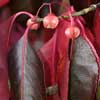 |
EUONYMUS
grandiflorus 'Red Wine Previously listed as E. atropurpurea var. cheatumii, this recent introduction has been re-classified and given a cultivar name as it is such a good plant. It differs from the species by it's narrower leaves and lower, bushier habit. Autumn colour is the most incredible deep bronzy purple with showy yellow and pink fruit capsules. My Choice of the genus! (maybe....!) |
|
|
|
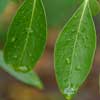 |
EUONYMUS
grandiflorus f. salicifolius A lovely graceful form with narrower leaves than the type. |
|
|
|
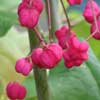 |
EUONYMUS hamiltonianus
'Calocarpus' This one stood out here last autumn, with a magnificent crop of fruit contrasting well against foliage that was still green. |
|
|
|
| NEW | EUONYMUS hamiltonianus
'Coral Charm' This selection originated at the Hillier Arboretum. It freely produces pale pink seed pods opening to show red seeds. A fantastic autumn plant, also having pretty pale yellow foliage colour. The seed pods of this group remain long after the leaves have fallen. |
|
|
|
| EUONYMUS hamiltonianus
'Den Haag' Particular selection. This selection typically doesn’t flower until August, to then be followed by pink fruits which ripen from October to December. Once established, it can produce stout branches each more than 1m long in a single season and when happy, these branches will be covered in fruit the following season. |
|
|
|
|
| EUONYMUS hamiltonianus 'Fiesta' | |
|
|
|
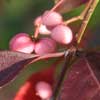 |
EUONYMUS
hamiltonianus 'Indian Summer' The virtues of this recent selection have been extolled as giving the best and most reliable autumn colours in its group. It certainly was spectacular last autumn, developing shades of fiery red and deep purple. Vigorous to 3-4m and easy to grow, this should be considered if an Acer is really out of contention. |
|
|
|
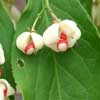 |
EUONYMUS
hamiltonianus 'Koi Boy' The white fruits are produced in late summer/early autumn, splitting to reveal striking bright red seeds resembling the contrasting colours of Japanese Koi carp - hence the name! The fruits persist into late autumn when the foliage turns to a pure lemon yellow. |
|
|
|
| NEW | EUONYMUS
hamiltonianus 'Miss Pinkie' A small, strong growing tree with beautiful pink fruit containing contrasting red-orange seeds. The heavy clusters are retained from September through to November. The large green leaves develop soft yellow autumn colour. |